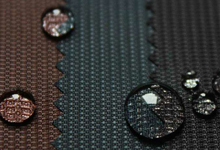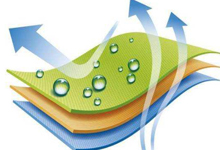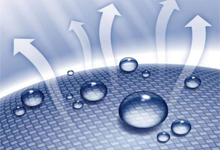Waterproof, moisture-permeable/breathable fabrics
Fluorine-based waterproofing agents (carbon eight waterproofing agents/carbon six waterproofing agents) have waterproof and oil-proof effects to varying degrees. , while the fluorine-free waterproofing agent only has waterproofing function, and its functionality is relatively simple. Based on years of research data and actual production, carbon eight waterproofing agents are more effective than carbon six waterproofing agents and fluorine-free waterproofing agents. And generally speaking, under the same conditions, the effect of carbon six waterproofing agent is better than that of fluorine-free waterproofing agent. The waterproof performance is: carbon eight waterproofing agent > carbon six waterproofing agent > fluorine-free waterproofing agent.
Whether a waterproofing agent can exert the best waterproofing effect on fabrics, in addition to the performance of the waterproofing agent itself, is also closely related to the processing of fabrics and processes. Waterproof finishing is a functional finishing, which can even be said to be a fine chemical finishing. Waterproof finishing of fabrics often requires that the surface of the treated fabric be smooth and clean, and even all residual additives on the pre-finished fabric must be removed, such as wetting agents, dyeing auxiliaries, slurry residues, softeners and other surfactants. This actually has something to do with the carbon chain structure of the waterproofing agent. Literally speaking, carbon eight waterproofing agent has 8 carbon chains, carbon six waterproofing agent only has 6 carbon chains, and fluorine-free waterproofing agent is a waterproofing agent without carbon molecules. Of course, the more carbon chains, the more stable the intermolecular structure, and of course the stronger the adaptability to residual impurities in the fabric. Among the three, carbon eight waterproofing agent is the most stable, followed by carbon six waterproofing agent, and the one with the greatest impact is fluorine-free waterproofing agent. This is why when carbon eight waterproofing agents were banned, most functional finishing brand manufacturers chose carbon six waterproofing agents as a substitute.
If you need to use these three waterproofing agents to achieve the same effect for the same fabric under the same conditions, then in terms of dosage, carbon eight < carbon six < fluorine-free waterproofing agent; that is, the dosage of fluorine-free waterproofing agent The largest, and generally speaking, the unit price of fluorine-free waterproofing agents is also higher. Looking at it this way, carbon six waterproofing agents will become even more popular in the next few years.

Through the analysis of the above aspects, the effect of carbon eight waterproofing is significant, but due to environmental issues, it can only Replaced by carbon six and fluorine-free waterproofing agents. Therefore, textile fabric companies must choose the most suitable products based on the company’s actual needs.
Waterproof principle and finishing process
Water-repellent finishing uses a finishing agent with low surface energy to be deposited on the fiber surface so that the fabric will not be wetted by water, but the fabric will still remain The large number of pores makes the fabric not only have good water repellency, but also have breathability and wettability, and the feel and segmentation of the fabric are not affected. Water permeability will only occur when the water pressure is considerable.
Waterproof finishing is to apply an airtight continuous film on the surface of the fabric, such as rubber, polyurethane, etc., to fill the pores in the fabric and use physical methods to block the penetration of water, even under the action of external water pressure It also has high resistance to water penetration, but it is often airtight and moisture-proof, and uncomfortable to wear. It belongs to the category of coating finishing. Although in recent years, with the advancement of coating technology, breathable, moisture-permeable and impermeable coated fabrics have long been available, but if they are not treated with a water-repellent agent or a water-repellent agent component is not added to the coating slurry, its surface will still be Will be wetted by water. Therefore, generally coated fabrics will be treated with water-repellent finishing.
Water-repellent principle: The wetting process of a liquid on a solid is actually a process in which the liquid replaces the gas on the solid surface. Water can spread smoothly on clean and flat glass, but water on a lotus leaf will not The shape of water droplets indicates that the degree of wetting of the solid surface by the liquid is different under different circumstances, and the shape of the liquid on the solid surface can indicate the degree of wetting of the solid surface by the liquid. As shown in the figure below, (a) represents a completely non-wetting situation (we need to achieve this state for waterproofing), (b) represents a situation with a higher degree of wetting, and (c) represents a situation with a higher degree of wetting. θ is the contact angle between the liquid and the solid surface. Among them, waterproof finishing means that the surface of the fabric has the property of not being wetted by water, that is, increasing the contact angle θ with water and reducing the adhesion work between them. That is, the surface tension γsg of the solid must be less than the surface tension γlg of the liquid.
As can be seen from the picture below, the surface tension of rainwater is 53mN/m, and the surface tension of general oil is 20~30mN/m. Therefore, to make the fabric water-repellent, the surface tension must be less than 53mN/m. , to make fabrics oil-repellent, the surface tension must be less than 20~30mN/m. General fibers or textiles are neither oil-repellent nor water-repellent (their surface tension is much greater than the surface tension of water or oil).
Water repellent and oil repellent are a type of oil repellent. Oil repellent is a compound with oil-repellent and low surface energy groups. It can be used to treat fabrics and evenly cover the fiber surface of the fabric with a layer of water repellent. Agent or oil repellent molecules, and their low surface energy atomic groups form a new surface so that neither water nor oil can be wetted. Water has a high surface tension (72.8mN/m). Therefore, sufficient hydrophobic aliphatic hydrocarbon compounds with a critical surface tension γc of about 30mN/m or a silicone finishing agent with a γc of about 24mN/m can be obtained. Water repellent. The surface tension of oil is 20~30mN/m, and fluorocarbon finishing agents must be used to reduce the critical surface tension of the fiber to below 15mN/m. Therefore, water-repellent agents generally use alkyl groups (–CnH2n+1, n>16).��Water group, oil repellent agent must use perfluoroalkyl group (–CnF2n+1, n>7) as the oil repellent group.
Factors affecting water and oil repellency of fabrics:

Fabric surface roughness: If the droplet is If the contact angle on a smooth surface is less than 90°, the contact angle on a rough surface will be smaller; if the contact angle on a smooth surface is greater than 90°, the contact angle on a rough surface will be larger. That is: a smooth surface that water cannot wet, if its surface is rough, water cannot wet it; a smooth surface that water can wet, if its surface is rough, water can wet it more easily. This is why the water-repellent effect of suede fabrics treated with water-repellent finishing is particularly good.
Fabric capillary gap size: When the contact angle is greater than 90° (i.e. oil-repellent, water-repellent or oil-repellent), reducing the yarn gap will increase the tightness and volume density of the fabric, which can improve the fabric’s tightness and volume density. The anti-water permeability property is beneficial to the water-repellent or oil-repellent properties of fabrics.
The structure, performance and finishing process of commonly used water- and oil-repellent agents:
The commonly used water-repellent agents at present are mainly silicone resins and fluorocarbon polymers, while oil-repellent agents are Fluorocarbon polymer.
Paraffin water repellent
Stearic acid-melamine water repellent
Silicone resin water repellent

Fluorocarbon polymer water and oil repellent
Waterproof finishing process:
From a production perspective, there is no obvious difference in the process between carbon eight, carbon six, and fluorine-free waterproofing agents. Basically, they need to be baked to produce a cross-linking effect. To put it simply: the waterproofing agent gives the fabric a waterproof effect, which means cross-linking occurs on the fabric. It requires the full cooperation of temperature, baking time, waterproofing agent, and pretreated fabric to achieve optimization.
Waterproof finishing generally adopts padding method, and generally does not require dipping process. For example, the finishing method is as follows: padding → drying → baking.
Water-repellent and oil-repellent finishing can be combined with other finishes. In coating finishing, in order to prevent the coating slurry from penetrating into the back of the fabric, the base fabric can be pre-treated with water-repellent and oil-repellent coating. Afterwards, water-repellent or oil-repellent finishing can increase the functionality of the fabric. Water and oil repellent finishing can also be combined with calendering. Calendering finishing is when the fabric passes through the nip point composed of the elastic soft roller and the metal hot roller. In the pressure zone, due to the deformation of the soft roller and the change of the roller diameter, a slight difference in the angular velocity of the fabric is caused, causing micro-sliding. Through surface shearing and pressing and rubbing, , causing the fibers to be heated in the nip and reach the glass transition temperature, thereby plasticizing and “flowing”, and being gently rubbed, so that the tightness of the fabric surface becomes consistent, and the fabric surface in contact with the metal roller is smoothed and reduced. The gaps between small interweaving points achieve ideal fabric air tightness and fabric surface finish. Although calendering finishing greatly reduces the breathability of the fabric, the resistance to linting is significantly improved, and the use of chemical coating additives is reduced. After calendering, some high-density fabrics can achieve excellent velvet resistance without coating.
Waterproof and breathable fabrics
Classification and process of coated fabrics
Textile coating finishing agent, also known as coating glue, is a kind of uniform coating on fabrics Surface polymer compounds. It forms one or more films on the surface of the fabric through adhesion, which not only improves the appearance and style of the fabric, but also increases the function of the fabric, making the fabric waterproof, water pressure resistant, breathable, flame retardant, antifouling, and light-shielding. Reflection and other special functions.
Textile coating finishing agent, also known as coating glue, is a polymer compound that is evenly coated on the surface of fabrics. It forms one or more films on the surface of the fabric through adhesion, which not only improves the appearance and style of the fabric, but also increases the function of the fabric, making the fabric waterproof, water pressure resistant, breathable, flame retardant, antifouling, and light-shielding. Reflection and other special functions.






